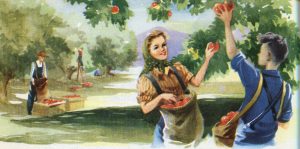 When I attended elementary school in Manitoba in the 1950s, our grade 4 or 5 reader was Wide Open Windows (Copp Clark, 1947) and one story we read was “Macs are Rolling‘ by Helen Dickson. My sister and I were fascinated by it then and still talk about it. It was probably of interest to us because we were farm kids and this was a story about farm kids who lived and worked on an apple farm in a place we could only imagine – the Okanagan! Their town on a Saturday evening was a lot like our nearby town on a Saturday evening. Now it’s August in the Okanagan and the “Macs are Rolling” once again.
When I attended elementary school in Manitoba in the 1950s, our grade 4 or 5 reader was Wide Open Windows (Copp Clark, 1947) and one story we read was “Macs are Rolling‘ by Helen Dickson. My sister and I were fascinated by it then and still talk about it. It was probably of interest to us because we were farm kids and this was a story about farm kids who lived and worked on an apple farm in a place we could only imagine – the Okanagan! Their town on a Saturday evening was a lot like our nearby town on a Saturday evening. Now it’s August in the Okanagan and the “Macs are Rolling” once again.
When I read the story as an adult, I can see all the hidden messages about work before pleasure,  importance of contributing to the family work load and economy, gender roles, etc. that the story is attempting to impart to children. Nevertheless, it was our first glimpse of the Okanagan and apple farming. We knew Macintosh apples because BC apples were heavily marketed across the prairies and we often had one in our school lunch. Macintosh apples are still the most popular apple variety in Canada, likely because they are good to eat raw or for baking.
importance of contributing to the family work load and economy, gender roles, etc. that the story is attempting to impart to children. Nevertheless, it was our first glimpse of the Okanagan and apple farming. We knew Macintosh apples because BC apples were heavily marketed across the prairies and we often had one in our school lunch. Macintosh apples are still the most popular apple variety in Canada, likely because they are good to eat raw or for baking.
Every August when the first Macintosh apples are at the Farmers’ Market, I think to myself “The Macs are Rolling” and can’t wait to enjoy the first of the season. Over the years, BC apples have been featured by Fruit Growers associations through recipe booklets like Apple Secrets (1931) by Alice Stevens that promoted apples as “the least expensive of all health foods.” The BC Apple Recipe Book (no date) was edited by Dorothy Britton, home economist at the Summerland Experimental Farm and promoted the versatility of apples in fresh and cooked forms.
There are lots of other Apple types, but the Macintosh will always be important to me.
